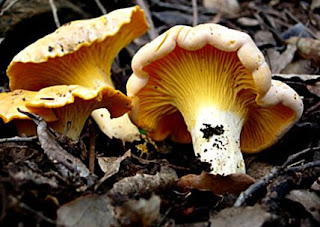Algarve's Tourist Guide - Nature and Environment of Algarve »Fauna and Flora do Algarve 'Mushrooms the Caldeirão (It can be found in the natural park of Querença, Cerro dos Negros Mountains, Fonte Benemola Water source, and around Querença)
Mushrooms of the Cauldron - Diversity of higher fungi in Cork forest
A fundamental component of forest ecosystems, the mushrooms can be an important source of income. In Serra do Caldeirão (Caldeirão Mountains), a study of the mushrooms, is one of the lines of work of a project to optimize the management of stands of cork forests.
In the Algarve, in the municipalities of São Brás de Alportel, Loulé and Tavira, extends the mountainous formation of Serra do Caldeirão. It is a territory consisting, mainly in forest and dominated by dense cork trees, on slopes sometimes very high. It is a Mediterranean ecosystem of unique features, resulting in a diverse flora and micro-flora of high wealth.
The project Agro, Measure 8, "Algarve's Cork Forests Management vegetation to reduce fire risks, increase socio-economic recovery and conservation of biodiversity" was held for two years a survey of the diversity of higher fungi, through the identification of mushrooms. The information was collected from 48 sample plots and over two seasons, autumn and winter from October to February and the season of spring that ran in April and May (between 2004 and 2006).
As the rain intensifies is strengthening its presence in the hills and valleys of Serra do Caldeirão, the mushrooms apear, showing and revealing the diversity of species living deep in the forest. All the mushrooms will parade along the time parts are essential to the vitality and health of forest ecosystems. Protect trees from pathogens attacks and help them get water and nutrients (AMF), degrade the organic matter by actively participating in the carbon cycle (saprobe), among other functions also important for the forest ecosystem.
The first mushrooms usually appear in October and are, among others, various species of the Genus Boletus and Amanita and the Macrolepiota procera. Early in the season appear valuable and very dangerous mushrooms. Only in the Genus Amanita is the gastronomic ecstasy, and the maximum toxicity, since the Amanita Caesarea is an excellent meat (Photo 2), but the Amanita phalloides (Photo 1) is deadly mortal.
In November we began to be presented with color and complexity of the world of Russula and Cortinários, two groups with high numbers of species and its identification could be difficult. Even in the late autumn other very interesting groups appear, as Clitocybe, Lactarius, and Tricholoma, each group is represented by several species, filling whith color the cork forests of Serra do Caldeirão.
When the winter arrives, arrived the Cantharellus, which highlights the Cantharellus cibarius, although you can find a lot less the Cantharellus lutescens and Cantharellus tubiformis. Even in this time, comes the Craterellus cornucopioides and Hydnum repandum, all these, a quite gourmet.
Finally, in early spring, making a reappearance of Boletus and some Russula and Lactarius, but may persist the Cantharellus cibarius, depending on the weather.
The search of mushrooms project that we talk above, revealed 130 species and 31 unidentified species due to the complexity of groups, and sometimes also due the state of deterioration that mushrooms have when they are found.
These 130 species represent 34 genera, mostly ectomycorrhizal but also including some saprobe, such as Agaricus.
The genus with the highest representation in these samples was 15% Russula species, followed by 11% Cortinarius, with 7.5% Lactarius, Tricholoma with the 6% and 4% Amanita species.
Moreover, the most abundant species in the overall sampling was chrysorrheus Lactarius mushrooms with 159, followed by 130 Cortinarius sp. Triumphant, and 126 triviallis Cortinarius mushrooms.
Mushrooms triviallis Cortinarius and Lactarius chrysorrheus are also more common in all types of woods, coming from areas plowed for 1 year to plots with weeds without intervention for more than 50 years, although occasional in woods recently intervened. The species Cortinarius sp. Triumphant section appeared only once, in a small area (100m) with bushes of approximate 15 years age, but with plenty of 130 mushrooms spicies.
In fact while some species are very adaptable and can easily arise after a soils intervention, as bushes clearing, others require areas with greater stability. This is the case of Cantharellus cibarius which only appeared in areas where the forest is not intervened more than 15-20 years and its gastronomic value implies a high economic value. This mushroom was sold in 2006, by the catcher, between 10 and 20 euros a kilogram, depending on the mushrooms amount available at the time.
On the other hand, there is the Amanita Caesarea which is a real myth among the mushrooms and then reaches, in other countries, a very high economic value. This mushroom only appeared in areas with recent intervention, as well as in woods until about 15 years without intervention,if there are open areas and some foliage on the ground. However, this mushroom is not sold by local collectors, who do not know it's gastronomic potencial, how edible and say see you saw this a few years.
Serra do Caldeirão have a very interesting Mycological wealth, although not yet identified all the species, because, 2 years is not enough time to make sure nd record all existing higher fungi. Moreover, it is possible to understand that there is a close relationship between the composition and age of the woods and the mushroom species that appear, and their abundance.
It is important to note that several species of mushrooms are highly toxic, its use can lead to death. The Algarve Tour Tavel Guide is not responsible for any incorrect identification of mushrooms species based on any of the content on this site. So, be carefull.
Nearby (15mn drive): Faro, Albufeira, Quinta do Lago, Vale do Garrão, Vilamoura, Loulé, Querença
Do you like our blog?
Please comment and add the AddThis social networks via the button below
Thank you!
















































































0 comentários:
Enviar um comentário